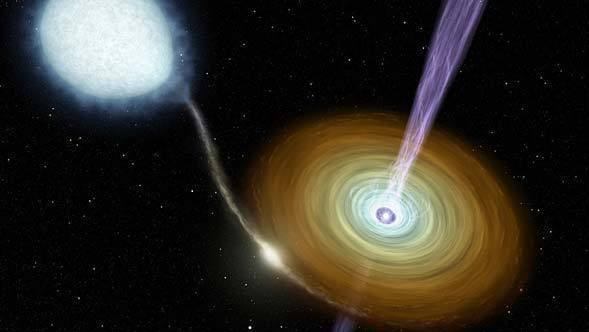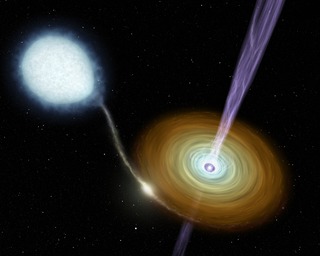
News Release • May 22nd, 2006 • feature06-16 •
Written by Linda Vu
Spitzer Science Center
One of the most mysterious aspects of black holes is their ability to shoot small, steady jets of matter into space near the speed of light. Until the sensitive infrared eyes of NASA's Spitzer Space Telescope recently spotted one of these jets around a nearby neutron star, or super-dense dead star, black holes were the only known objects in the universe with this "talent."
"For years, scientists suspected that something unique to black holes must be fueling the continuous compact jets because we only saw them coming from black hole systems. Now that Spitzer has revealed a steady jet coming from a neutron star in an X-ray binary system, we know that the jets must be fueled by something that both systems share," said Dr. Simone Migliari of the University of California at San Diego. Migliari is the lead author of a paper that was published in the May 20, 2006 issue of Astrophysical Journal Letters.
A neutron star X-ray binary system occurs when a companion star orbits a dead star that is so dense all of its atoms have collapsed into neutrons, hence the name "neutron star." The partner circles the neutron star the same way Earth orbits the Sun. Migliari used Spitzer to study a jet in one such system called 4U 0614+091. In this system, the neutron star is more than 14 times the mass of its orbiting companion.
As the smaller object travels around its massive partner, the neutron star's intense gravity collects the material leaving its stellar companion's atmosphere and creates a disk around itself. The disk of matter, or accretion disk, circles the neutron star similar to the way rings circle Saturn. According to Migliari, accretion disks and intense gravitational fields are characteristics that black holes and neutron stars in X-ray binaries share.
"Our data shows that the presence of an accretion disk and an intense gravitational field may be all we need to form and fuel a compact jet," he said.
Typically, radio telescopes are the tool of choice for observing compact jets around black holes. At radio wavelengths, astronomers can isolate the jet from everything else in the system. However, because the compact jets of a neutron star can be more than 10 times fainter than those of a black hole, using a radio telescope to observe a neutron star's jet would take many hours.
With Spitzer's super-sensitive infrared eyes, Migliari's team detected 4U 0614+091's faint jet in minutes. The infrared telescope also helped astronomers infer details about the jet's geometry. System 4U 0614+091 is located approximately 10,000 light-years away in the constellation Orion.
Other co-authors of this research include: John Tomsick of the University of California at San Diego; Elena Gallo University of California at Santa Barbra, Santa Barbra, Calif.; Gijs Nelemans of the University of Nijmegen in the Netherlands; and Thomas Maccarone, David Russell, and Rob Fender of the University of Southampton in the United Kingdom.
Related Links
- UCSD Press Release: Astrophysicists Discover 'Compact Jets' from Neutron Star





